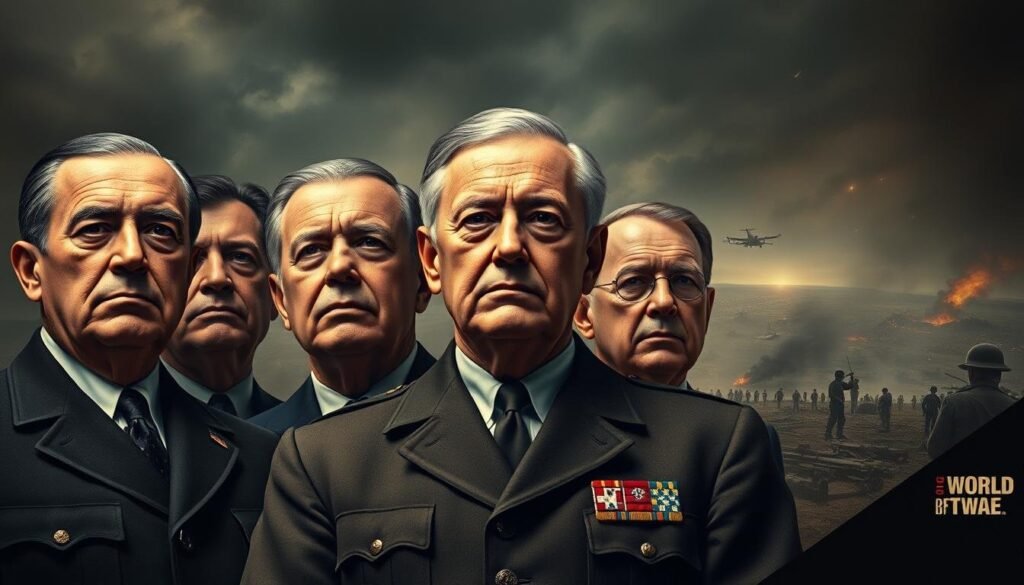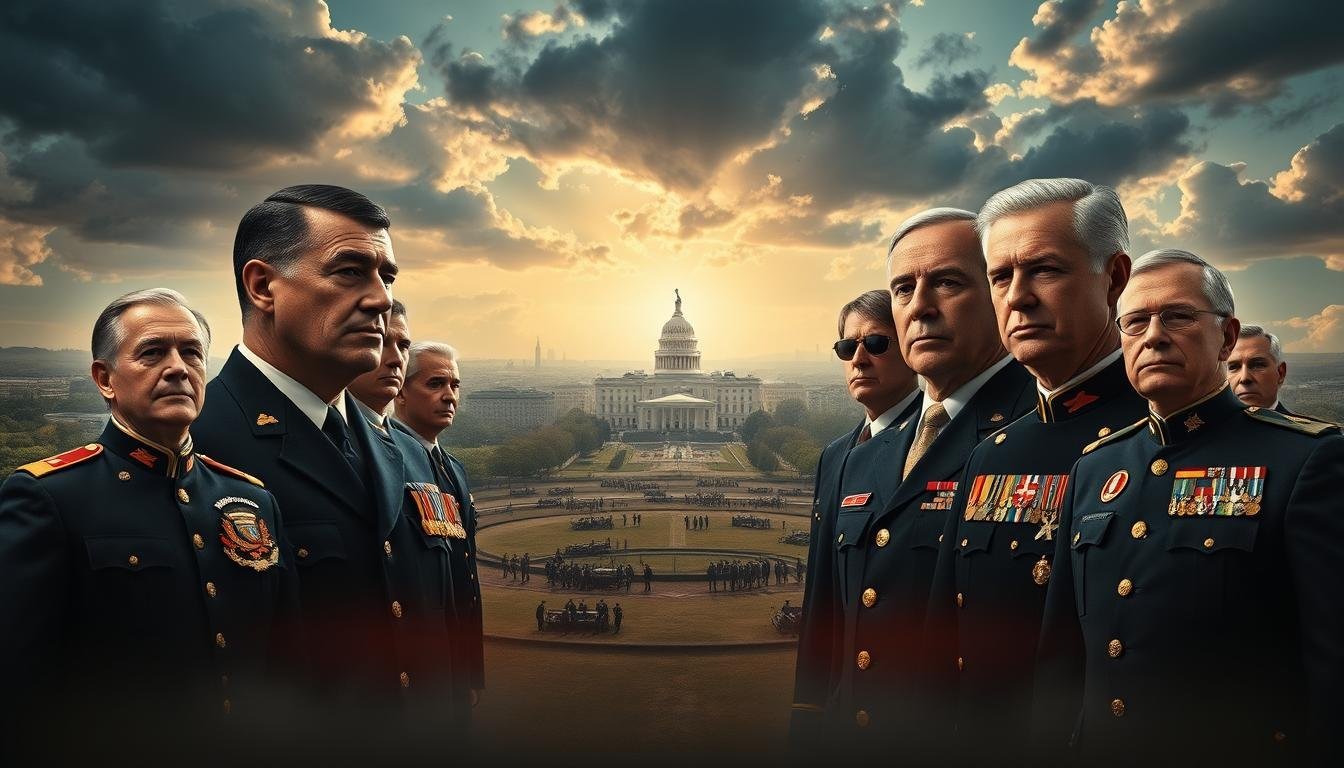Did Any US Presidents Serve in WWI and WWII? Have you ever wondered if US leaders were involved in big global wars? The story of Presidential Military Service is really interesting. It often changed how they led the country.
US leaders played big roles in wars like WWI and WWII. Some even fought in both. Knowing about their military careers helps us understand their decisions as leaders.
Let’s look into their military service. You’ll see how much they were involved and how it affected their time in office. [Did Any US Presidents Serve in WWI and WWII?]
Contents
- 1 US Presidents and Their Military Service
- 2 Did Any US Presidents Serve in World War1 and World War2?
- 3 Dwight D. Eisenhower’s Service Record
- 4 Harry S. Truman’s Military Career
- 5 Other Notable Presidential Military Service
- 6 How World War Experience Shaped Presidential Leadership
- 7 Conclusion: Did Any US Presidents Serve in WWI and WWII?
- 8 FAQ
- 8.1 Which US Presidents served in World War I?
- 8.2 Did Dwight D. Eisenhower serve in both World War I and World War II?
- 8.3 How did Harry S. Truman’s military service influence his presidency?
- 8.4 What was Dwight D. Eisenhower’s role in World War II?
- 8.5 Are there other US Presidents who served in World War I or World War II?
- 8.6 How did World War experience shape presidential leadership?
- 8.7 Which US President had the most significant military career before becoming President?
US Presidents and Their Military Service
US Presidents have a rich history of military service. They have experiences from combat zones to commanding armies. Their military backgrounds offer valuable insights into their leadership abilities.
Many US Presidents served in the military before becoming President. They played various roles that shaped their leadership styles. Some served in combat, while others commanded armies.
| President | Military Branch | Highest Rank |
|---|---|---|
| Dwight D. Eisenhower | US Army | General |
| Harry S. Truman | US Army | Colonel |
| John F. Kennedy | US Navy | Lieutenant |
The diverse military experiences of US Presidents have shaped their leadership styles. By looking at their Presidential Military Service, we can understand how their careers influenced their decisions in office.
Did Any US Presidents Serve in World War1 and World War2?
When looking at US Presidents’ military backgrounds, you might ask if any served in both World War I and World War II. This question is natural, given the huge impact these wars had on the world. It also shows the leadership roles these individuals later took on.
To answer this, let’s look at the service records of US Presidents in both wars. World War I and II were key moments in history. The involvement of future US Presidents in these conflicts shows their dedication to service.
Examining the Service Records of US Presidents
The military service of US Presidents in World War I and World War II was quite different. Some Presidents were directly involved in these conflicts, while others did not see combat. For example, several US Presidents served in World War II, with some holding important military roles.
When we think of US Presidents who served in both World War I and World War II, one example stands out. However, very few Presidents were involved in both wars. Yet, some did serve in one or the other. Their experiences greatly influenced their political careers later on.
Understanding the roles US Presidents played in World War I and II gives us insight into their leadership. The challenges of these wars shaped their views. This, in turn, affected their governance and international relations.
Dwight D. Eisenhower’s Service Record
Eisenhower’s military service was key to his presidency. You’ll see how his time at West Point and as Supreme Commander in WWII shaped him. [Did Any US Presidents Serve in WWI and WWII?]
Dwight D. Eisenhower graduated from West Point in 1915. This was the start of his notable military career. He didn’t fight in WWI but helped prepare troops for battle. His leadership was clear from the start, and he kept moving up.
In WWII, Eisenhower’s strategic mind and leadership were crucial. As Supreme Commander of the Allied Forces in Europe, he led key operations. The D-Day invasion of Normandy was one of them. His skill in working with other leaders was vital for success.
Eisenhower’s presidential military service showed his dedication to democracy. He made tough choices under pressure. His war experiences greatly influenced his leadership as President.
- Graduated from West Point in 1915
- Played a crucial role in preparing troops for WWI
- Served as Supreme Commander of the Allied Forces in Europe during WWII
- Oversaw the D-Day invasion of Normandy
Dwight D. Eisenhower’s military service shows his dedication and leadership. As President, he used these lessons to make important decisions. These decisions helped shape American history.
Harry S. Truman’s Military Career
Harry S. Truman’s military career was key in shaping him as a leader. His World War I experiences greatly influenced his life and presidency. [Did Any US Presidents Serve in WWI and WWII?]
Truman became a captain in the Field Artillery in 1917. He led Battery D, 129th Field Artillery Regiment, in France. His unit fought in the Battle of Saint-Mihiel and the Meuse-Argonne Offensive.
Truman showed great leadership and courage in combat. His ability to lead was clear. He also reformed a troubled unit, Battery D, earning his men’s respect.
After the war, Truman went into politics in Missouri. He eventually became President. His military background shaped his leadership and decision-making.
Truman’s military career shows his strong character and leadership. It helps us understand his presidency and the big decisions he made.
Other Notable Presidential Military Service
Many US Presidents have had impressive military careers. These experiences have greatly influenced their leadership. It’s interesting to see how different their military backgrounds are. [Did Any US Presidents Serve in WWI and WWII?]
Theodore Roosevelt, the 26th President, is a great example. He created the Rough Riders, a volunteer cavalry, during the Spanish-American War. His experiences in combat and leadership greatly shaped his policies and image.
Jimmy Carter, the 39th President, was a submariner in the US Navy. His time in the military taught him duty and discipline. These values stayed with him during his presidency.
George H.W. Bush, the 41st President, was a naval aviator in World War II. He was shot down over the Pacific and survived on a life raft. His wartime experiences deeply influenced his political career.
| President | Military Branch | Conflict |
|---|---|---|
| Theodore Roosevelt | US Army | Spanish-American War |
| Jimmy Carter | US Navy | Cold War |
| George H.W. Bush | US Navy | World War II |
These stories show the diverse military experiences of US Presidents. Their service has shaped their leadership and policy decisions. It has played a big role in American history. [Did Any US Presidents Serve in WWI and WWII?]
How World War Experience Shaped Presidential Leadership
Learning about US Presidents’ experiences in World War I and II can give us insights into their leadership. Their military service during these times greatly shaped their presidential leadership styles.
Dwight D. Eisenhower’s time as a general in World War II, for example, influenced his strategic thinking and leadership as President. Harry S. Truman’s service in World War I also shaped his presidency, including his tough decisions about the atomic bomb.

The effects of World War I and II on these leaders went beyond military strategies. It also influenced their leadership philosophies. By looking at their experiences, we can better understand the complexities of presidential leadership and the factors that guide their decisions.
In summary, the experiences of US Presidents in World War I and II were key in shaping their leadership styles and approaches. This knowledge helps us appreciate the complexities of their decision-making processes.
Conclusion: Did Any US Presidents Serve in WWI and WWII?
You’ve learned how US Presidents’ military service, especially in WWI and WWII, shaped their leadership. By looking at their Presidential Military Service records, we see the challenges they faced. We also see how their leadership styles developed.
The experiences of US Presidents in WWI and WWII show how important their military service was. Leaders like Dwight D. Eisenhower and Harry S. Truman used their military backgrounds. They made decisions and led based on what they learned in the military.
Learning about the military service of US Presidents gives us insight into their leadership. It also helps us understand the historical context of their time in office. Reflecting on the US Presidents WWI WWII experiences, we can see the complexities of their roles. We can also see how their military service impacted their presidency.
See Also: Why Was Eisenhower a Good President?
FAQ
Which US Presidents served in World War I?
Harry S. Truman and Dwight D. Eisenhower are notable US Presidents who served in World War I. Eisenhower did not see combat but played a big role. Truman served in France during the war. [Did Any US Presidents Serve in WWI and WWII?]
Did Dwight D. Eisenhower serve in both World War I and World War II?
Yes, Dwight D. Eisenhower served in both World War I and World War II. He didn’t see combat in WWI but was key in WWII. He was the Supreme Commander of the Allied Forces in Europe.
How did Harry S. Truman’s military service influence his presidency?
Harry S. Truman’s military service in World War I shaped his leadership. His experiences influenced his presidency, especially his decision to drop atomic bombs on Hiroshima and Nagasaki.
What was Dwight D. Eisenhower’s role in World War II?
Dwight D. Eisenhower was the Supreme Commander of the Allied Forces in Europe during World War II. He was crucial in planning and executing the D-Day invasion of Normandy and other key operations.
Are there other US Presidents who served in World War I or World War II?
Yes, several US Presidents have served in World War I or World War II. Not all saw combat, but their service greatly impacted their leadership styles and presidencies. [Did Any US Presidents Serve in WWI and WWII?]
How did World War experience shape presidential leadership?
The experiences of US Presidents in World War I and World War II greatly shaped their leadership. Their military service influenced their decision-making and leadership approaches. It gave them valuable insights into crisis management.
Which US President had the most significant military career before becoming President?
Dwight D. Eisenhower is often seen as having the most significant military career before becoming President. His experience as a senior military leader in World War II greatly influenced his presidency. [Did Any US Presidents Serve in WWI and WWII?]

Hi, I am Tatum Bradford from Washington. I have a background in political science and work as a senior revenue officer. I love learning about U.S. presidents and sharing interesting facts about political history.

